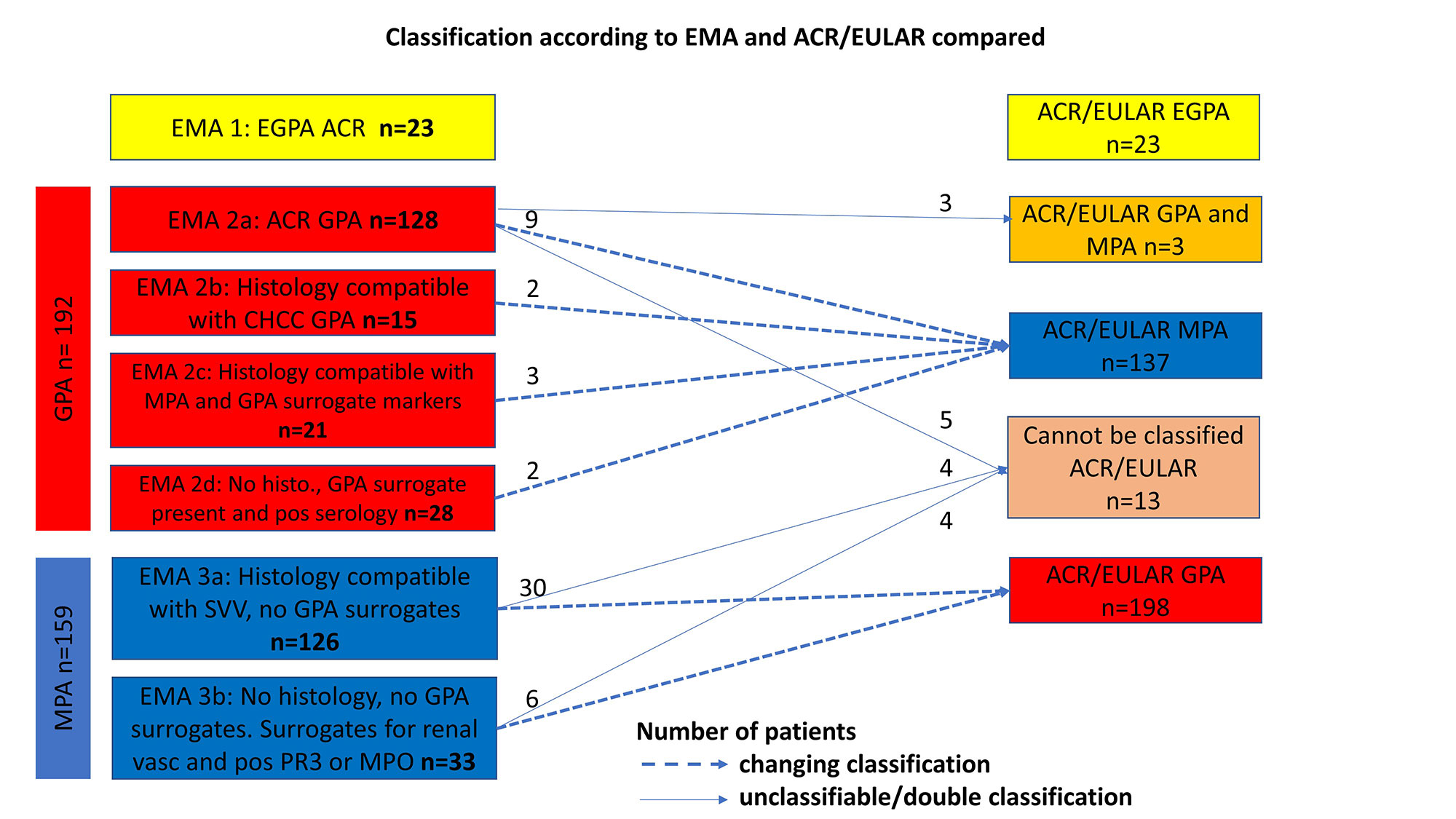Session Information
Date: Saturday, November 12, 2022
Title: Vasculitis – ANCA-Associated Poster I: Epidemiology, Outcomes, and Classification
Session Type: Poster Session A
Session Time: 1:00PM-3:00PM
Background/Purpose: The classification of ANCA- associated vasculitis (AAV) has been an area of controversy for many years. Available classifications and definitions are either overlapping and/or do not include important diagnostic tools and surrogate markers. However, the EMA algorithm combines the most widely used systems in hierarchic manner which has diminished the problem of overlap and has gained increasing popularity during the last 15 years. Some researchers prefer a simple but robust classification based on ANCA serology. The most recent effort to develop classification criteria of AAV is the ACR/EULAR classification criteria for GPA, MPA and EGPA. These criteria were recently published and have not yet been used or validated in a real-life setting. To evaluate the recently published 2022 ACR/EULAR classification criteria for AAV in a population-based cohort and compare it with the EMA algorithm and the with a strict ANCA -serology based classification.
Methods: All incident cases of AAV diagnosed between 1997 and 2019 vasculitis from a defined geographic area in Sweden were included. All cases have a clinical diagnosis of small vessel vasculitis supported by histology, serology and/or surrogate markers of vasculitis. All cases were classified according to the EMA-algorithm. Cases were reclassified according to the new ACR/EULAR 2022 and agreement rate was assessed compared to classification by EMA-algorithm. In addition, a classification was done according to ANCA specificity, i.e. MPO-ANCA and PR3-ANCA.
Results: Three-hundred-seventy-four cases (47% female) of AAV are included in this report. When classified according to EMA, 192 patients are classified as GPA, 159 as MPA and 23 as EGPA. When applying ACR/EULAR criteria 198 patients are classified as GPA, 137 as MPA and 23 as EGPA, 3 patients are classified to GPA as well as MPA. In addition, 13 patients cannot be classified according to the new criteria (Figure 1). The observed agreement between the two classification criteria were 84% for GPA, 75% for MPA and 100% for EGPA (Table 1). The κ statistic was 0.65 (95% confidence interval 0.57-0.72) for GPA and 0.66 (95% CI 0.58-0.73) for MPA. 184 of the 186 (98.9%) PR3-ANCA positive patients were classified as GPA using the ACR/EULAR criteria, and 138 of 153 (90%) of MPA-ANCA positive patients were classified as MPA (EGPA were excluded from serology classification).
Conclusion: We observe differences in classification outcome compared to EMA-algorithm. Compared with the EMA-algorithm 3.5% of the patients are unclassifiable while 1.1 % receive two diagnoses with the new ACR/EULAR criteria. If only PR3-ANCA and MPO-ANCA positivity were used as a single classification criterium, we observe an agreement of almost 99% for GPA and 90% for MPA demonstrating the considerable weight granted to ANCA-specificity in the new ACR/EULAR criteria. To what extent the new classification represents an improvement remains to be elucidated.
To cite this abstract in AMA style:
Rathmann J, Segelmark M, Mohammad A. Evaluation of the 2022 ACR/EULAR Classification Criteria for ANCA-Associated Vasculitis in a Population-based Cohort from Sweden [abstract]. Arthritis Rheumatol. 2022; 74 (suppl 9). https://acrabstracts.org/abstract/evaluation-of-the-2022-acr-eular-classification-criteria-for-anca-associated-vasculitis-in-a-population-based-cohort-from-sweden/. Accessed .« Back to ACR Convergence 2022
ACR Meeting Abstracts - https://acrabstracts.org/abstract/evaluation-of-the-2022-acr-eular-classification-criteria-for-anca-associated-vasculitis-in-a-population-based-cohort-from-sweden/


